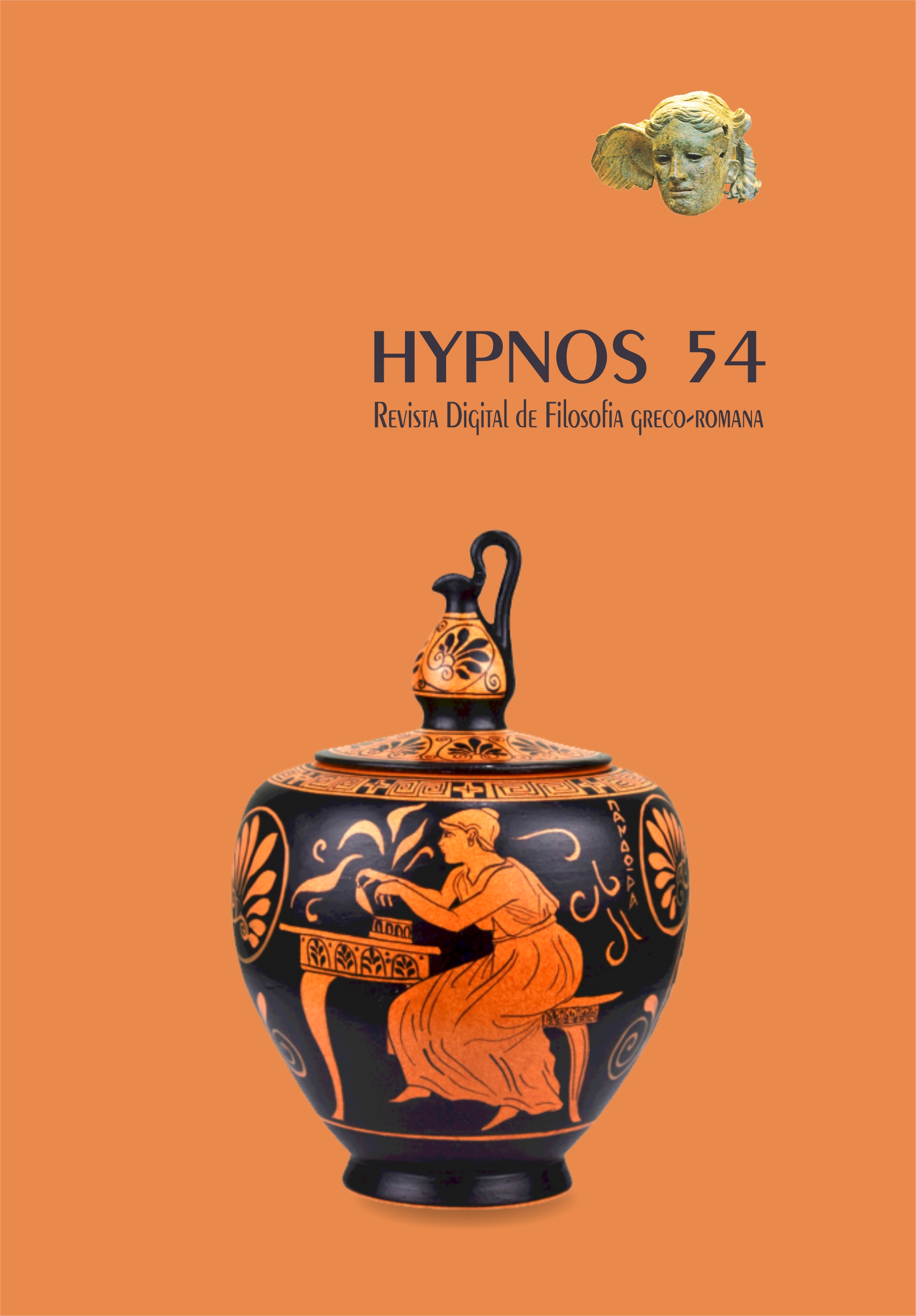Spontaneous Generation in Aristotle under an analysis of Necessary Natural Processes
Keywords:
Spontaneous generation, natural necessities, compositional processes, living organisms, inanimate homogeneous bodiesAbstract
I aim, in this paper, to develop an investigation regarding the necessary natural processes involved in the compositional activity of spontaneously generated living organisms in Aristotle. In order to elaborate this investigation, I’ll try to conduct an explanatory reasoning in which certain types of necessity will be delimited, involved in the study of different beings and natural phenomena, which can be identified in Aristotelian treatises of natural philosophy. From this investigation, I’ll then draw a comparative examination between the compositional activities of inanimate homogeneous bodies (metals/minerals) and of living beings generated by spontaneity. With this, I intend to establish a certain understanding or discernment about the nature of spontaneous generation in Aristotle.
References
ARISTÓTELES. Aristotelis Opera. BEKKER, I. (ed.). Academia Regia Borussica, Vols. I-II, Berlim, 1831.
ARISTÓTELES. Aristotelis meteorologicorum libri quattuor. F.H. Fobes - Cambridge, Mass.: Harvard University Press, 1919.
ARISTÓTELES. Aristotle's metaphysics, 2 vols. W.D. Ross - Oxford: Clarendon Press, 1924.
ARISTÓTELES. Aristotelis physica. W.D. Ross - Oxford: Clarendon Press, 1950.
ARISTÓTELES. Meteorologica. H. D. P. Lee - London: The Loeb Classical Library, 1952.
ARISTÓTELES. On the Soul. Parva Naturalia. On Breath. Translated by W. S. Hett. Loeb Classical Library 288. Cambridge, MA: Harvard University Press, 1957.
ARISTÓTELES. Posterior Analytics – Topica. Translated by Hugh Tredennick and Forster, E. S. Loeb Classical Library. Cambridge, MA: Harvard University Press, 1960.
ARISTÓTELES. De anima. W.D. Ross - Oxford: Clarendon Press, 1961.
ARISTÓTELES. Parts of Animals; Movement of Animals; Progression of Animals. A. L. - Peck. London: The Loeb Classical Library, 1961.
ARISTÓTELES. Aristotelis de generatione animalium. H.J. Drossaart Lulofs - Oxford: Clarendon Press, 1965.
ARISTÓTELES. Reproduccíon de los Animales. Trad. e notas de E. Sánchez. Madrid: Biblioteca Clásica Gredos, 1994.
ARISTÓTELES. Acerca del Cielo; Meteorológicos. Trad. e notas de M. Candel. Madrid: Biblioteca Clásica Gredos, 1996.
ARISTÓTELES. Acerca de la Generación y la Corrupción; Tratados Breves de Historia Natural. Trad. e notas de E. La Croce, e A. B. Pajares. Madri, Biblioteca Clásica Gredos, 1998.
ARISTÓTELES. As Partes dos Animais, Livro I. Trad. e comentários de L. Angioni. Cadernos de História e Filosofia da Ciência, 9 (3) (n. especial), 1999.
ARISTÓTELES. Partes de los Animales; Marcha de los Animales; Movimiento de los Animales. Trad. e notas de E. J. Sánchez-Escariche, e A. A. Miguel. Madri, Biblioteca Clásica Gredos, 2000.
ARISTÓTELES. Física. Trad. e notas de G. R. de Echandía. Madri, Biblioteca ClásicaGredos, 2002.
ARISTÓTELES. Acerca del Alma. Trad. e notas de T. C. Martínez. Madri, Biblioteca Clásica Gredos, 2003.
ARISTÓTELES. Metafísica. Trad. e notas de T. C. Martínez. Madri, Biblioteca Clásica Gredos, 2006.
ARISTÓTELES. Física I-II. Trad. e comentários de L. Angioni. Campinas: Ed. Unicamp, 2009.
Literatura Especializada:
ANGIONI, L. As partes dos animais, Livro I. Tradução e comentários de L. Angioni. Cadernos de História e Filosofia da Ciência, 9 (3) (n. especial), 1999.
ANGIONI, L. ao acabamento de dada composição, em vista da qual certas séries causais vêm a ser intrinsecamente entrecruzadas de uma maneira determinadaFísica I-II. Trad. e comentários de L. Angioni. Campinas: Ed. Unicamp, 2009
BALME, D. M. "Development of Biology in Aristotle and Theophrastus: Theory of Spontaneous Generation". In Phronesis, Vol. 7, n. 1, pp. 91-104, 1962.
COHEN, S. M. Aristotle on Nature and Incomplete Substance. New York: Cambridge University Press, 1996.
COOPER, J. M. “Hypothetical necessity and natural teleology”. In A. Gotthelf e Lennox, J. (eds.), Philosophical Issues in Aristotle’s Biology. Cambridge: Cambridge University Press, 1987, pp. 243-274.
FREUDENTHAL, G. Aristotle’s Theory of Material Substance: Heat and pneuma, Form and Soul. Oxford, 1995.
FURTH, M. Substance, form and Psyche: an Aristotelian metaphysics. Cambridge: Cambridge University Press, 1988.
GILL, Mary L. “Material Necessity and Meteorology IV 12”. In Aristotelische Biologie - Intentionen, Methoden, Ergebnisse. Stuttgart: Franz Steiner, pp. 145-161, 1997.
GOTTHELF, A. “Teleology and spontaneous generation in Aristotle: a discussion”. In: T. Penner e R. Kraut (eds.), “Nature Knowledge and Virtue” (Essays in memory of Joan Kung). Apeiron 22, n. 4 (n. especial), 1989, pp.181-193.
HULL. David. “The Conflict between Spontaneous Generation and Aristotle’s Metaphysics”. In Proceedings of the Seventh Inter-American Congress of Philosophy, Quebec, Canada: Les Presses de l’Universite Laval, pp. 245-250, 1967.
LENNOX, James G. “Teleology, Chance, and Aristotle's Theory of Spontaneous Generation”. In Journal of the History of Philosophy, Volume 20, Number 3, pp. 219-238, 1982.
LEUNISSEN, M. “Nature as a Good Housekeeper: Secondary Teleology and Material Necessity in Aristotle’s Biology”. In Apeiron, 43 (4):117-142, 2010.
LEUNISSEN, M. “Teleology in Aristotle”. In Teleology: A History (Oxford Philosophical Concepts Series). Edited by Jeffrey K. McDonough. Oxford University Press, 2020.
MANSION, A. Introduction à la Physique Aristotélicienne (2éme édition revue et augmentée). Louvain: Institut Supérieur de Philosophie, 1945.
NUSSBAUM, M. C. Aristotle’s De motu animalium text with translation, commentary, and interpretive essays. Princeton. Princeton University Press, 1985.
STAVRIANEAS, S. “Spontaneous Generation in Aristotle’s Biology”. In Rhizai, V.2, pp. 303–338, 2008.
Downloads
Published
Issue
Section
License
Copyright (c) 2025 Hypnos Journal

This work is licensed under a Creative Commons Attribution-NonCommercial-ShareAlike 4.0 International License.
The contents of the manuscript have been tacitly or explicitly approved by the responsible authorities where the research was carried out.
Upon acceptation of the manuscript, the author agrees to allow its publication by Hypnos, declining pecuniary gains due from copyright. If the manuscript is published later in other media, the author agrees to always give credits of its first publication in Hypnos.
If the submitted document includes figures, tables, or large sections of text previously published, the author declares himself responsible for having obtained permission of the original copyright owners of these items for both the online and printed publication of this journal. Credits for copyrighted material must be properly attributed in the manuscript.


 A revista
A revista 